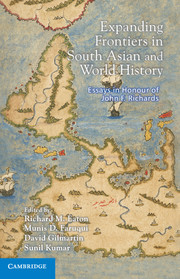Book contents
- Frontmatter
- Contents
- List of Contributors
- Foreword
- Introduction
- 1 At Empire's End: The Nizam, Hyderabad and Eighteenth-century India
- 2 The Ignored Elites: Turks, Mongols and a Persian Secretarial Class in the Early Delhi Sultanate
- 3 ‘Silk Road, Cotton Road or … Indo-Chinese Trade in Pre-European Times’
- 4 The Political Economy of Opium Smuggling in Early Nineteenth Century India: Leakage or Resistance?
- 5 Opium and the Company: Maritime Trade and Imperial Finances on Java, 1684–1796
- 6 The Mughals, the Sufi Shaikhs and the Formation of the Akbari Dispensation
- 7 Notes on Political Thought in Medieval and Early Modern South India
- 8 Becoming Turk the Rajput Way: Conversion and Identity in an Indian Warrior Narrative
- 9 Nature and Nurture on Imperial China's Frontiers
- 10 The Frontiers of Memory: What the Marathas Remembered of Vijayanagara
- 11 ‘Kiss My Foot,’ Said the King: Firearms, Diplomacy and the Battle for Raichur, 1520
- 12 Frontiers of Family Life: Early Modern Atlantic and Indian Ocean Worlds
- 13 Chinese Revenue Farms and Borders in Southeast Asia
- Publications
- Index
1 - At Empire's End: The Nizam, Hyderabad and Eighteenth-century India
Published online by Cambridge University Press: 05 January 2014
- Frontmatter
- Contents
- List of Contributors
- Foreword
- Introduction
- 1 At Empire's End: The Nizam, Hyderabad and Eighteenth-century India
- 2 The Ignored Elites: Turks, Mongols and a Persian Secretarial Class in the Early Delhi Sultanate
- 3 ‘Silk Road, Cotton Road or … Indo-Chinese Trade in Pre-European Times’
- 4 The Political Economy of Opium Smuggling in Early Nineteenth Century India: Leakage or Resistance?
- 5 Opium and the Company: Maritime Trade and Imperial Finances on Java, 1684–1796
- 6 The Mughals, the Sufi Shaikhs and the Formation of the Akbari Dispensation
- 7 Notes on Political Thought in Medieval and Early Modern South India
- 8 Becoming Turk the Rajput Way: Conversion and Identity in an Indian Warrior Narrative
- 9 Nature and Nurture on Imperial China's Frontiers
- 10 The Frontiers of Memory: What the Marathas Remembered of Vijayanagara
- 11 ‘Kiss My Foot,’ Said the King: Firearms, Diplomacy and the Battle for Raichur, 1520
- 12 Frontiers of Family Life: Early Modern Atlantic and Indian Ocean Worlds
- 13 Chinese Revenue Farms and Borders in Southeast Asia
- Publications
- Index
Summary
INTRODUCTION
In May 1748, Nizam-ul-Mulk Asaf Jah arrived in the central Indian city of Burhanpur. He was seventy seven years old and exhausted after undertaking an extensive tour of his dominion. While in Burhanpur, the Nizam caught a cold that caused his health to swiftly deteriorate. Sensing death upon him, the Nizam called a gathering of close confidants and family. The atmosphere was intimate and sad. Among other matters, the Nizam dictated his last testament (wasiyyatnama). Spanning seventeen clauses, this testament was intended to provide insights into a lifetime of almost unparalleled success in statecraft and a template of how to govern Hyderabad, the nascent state founded by him in the early 1720s in south-central India. Although the tone and content of the will suggest the Nizam is worried about the future of Hyderabad, he also seems concerned to shape his own historical legacy. There is little doubt that the Nizam wished to be remembered as the most successful politician, general and administrator among the post-Mughal rulers. The will is occasionally pontificatory and self-aggrandizing, yet there can be no disagreeing with the Nizam's own conclusion that he had lived a blessed life. Here, after all, was a man who had not only survived, but also thrived amidst the uncertainty accompanying the collapse of the Mughal Empire during the first decades of the eighteenth century.
- Type
- Chapter
- Information
- Expanding Frontiers in South Asian and World HistoryEssays in Honour of John F. Richards, pp. 1 - 38Publisher: Cambridge University PressPrint publication year: 2013

